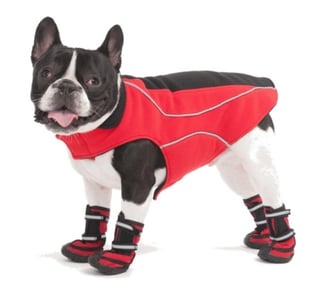 Winter is here, and while the snow may look beautiful, it can also be a cause for concern. There is the obvious trouble like ice patches, slippery conditions and dangerous roads, but what about the trouble winter can cause for your pet?
Winter is here, and while the snow may look beautiful, it can also be a cause for concern. There is the obvious trouble like ice patches, slippery conditions and dangerous roads, but what about the trouble winter can cause for your pet?
Your furry friends still need to get some fresh air, even when the weather is less than pleasant. Luckily, there are a few easy ways to make sure they are protected this winter.
We interviewed pet expert Allie Christman, from the Wisconsin Humane Society, to get some great pet safety tips! Because believe it or not, asphalt pavement safety and pet safety have a lot in common!
How does road salt affect dogs?
Rock salt irritates your dog’s paws and can cause chapping or cracking, but it can also be toxic if they ingest too much. If your dog’s paws were exposed on a walk, make sure to wipe down their feet and belly with a damp towel so they aren’t tempted to lick at it. Symptoms of salt poisoning include vomiting, diarrhea, lack of appetite, lethargy, unsteady walking, abnormal fluid retention, excessive thirst or urination, or tremors. Left untreated, salt poisoning can even lead to death, so it’s important to contact your vet immediately if you suspect they’re ill. You can learn more about sanding and salting, along with other ways to keep your asphalt protected here.
How can businesses consider the safety of pets as they prepare for winter?
Both homes and businesses can play an active role in animal safety this winter by using a pet friendly ice-melter like Paw Thaw. This product combines all the most effective de-icing components available while remaining biodegradable and non-toxic. It even guards against concrete corrosion and provides added traction control.
Another important consideration: outdoor cats and other animals often gravitate toward the warmth of a recently-used engine during the winter. If you operate machinery or have company vehicles, give the horn a quick honk or two before starting the engine to spook away any animals who might be hiding in a wheel well, under the vehicle, or near the exhaust pipe.
What advice do you have for pet owners near businesses or near parking lots?
We know that salt can be dangerous for dogs in the winter, but it’s also very important to keep your antifreeze stored away and to clean up any spills quickly. It can smell sweet to our pets, but its ethylene glycol can be lethal if ingested by a dog or cat. Some symptoms of ethylene glycol ingestion are: drooling, vomiting, unsteady walking, seizures, or lethargy. If you suspect your pet has ingested antifreeze, see a veterinarian immediately.
Tips to safely walk your pet in the winter
 As winter sets in, it’s important to keep your four-legged friends safe and warm. Doggie clothing isn’t just for looks! Dogs with short or thin coats, senior pets, and young puppies could all benefit from a canine coat or sweater. Booties can be a very effective way to protect paws from the cold pavement, ice, or rock salt, and also provide added traction to avoid falls; there are many options available so you may need to experiment with what works best for your pet.
As winter sets in, it’s important to keep your four-legged friends safe and warm. Doggie clothing isn’t just for looks! Dogs with short or thin coats, senior pets, and young puppies could all benefit from a canine coat or sweater. Booties can be a very effective way to protect paws from the cold pavement, ice, or rock salt, and also provide added traction to avoid falls; there are many options available so you may need to experiment with what works best for your pet.
If your dog isn’t used to wearing a coat or booties, it may feel very foreign and cause them to react uncomfortably. The trick is to ease them into it gradually with lots of positive reinforcement along the way. Start by putting the coat or booties on and immediately giving them treats, praise, or their favorite toy, then removing the clothing right away. Repeat the process again a few hours later or even the next day, but leave the item on them a little longer each time until they eventually seem comfortable with it and are freely moving around the house in their new outfit. Now you can take them for their usual walk or romp in the back yard wearing their winter gear, but keep treats on hand in case they start to get uncomfortable again. The more you can associate their new outfit with good things like treats or toys, the more they’ll enjoy wearing it.
If you’ve tried this gradual acclimation without success or if you find yourself in a cold snap without time to train your hesitant pup, you may want to try a product like Paw Guard. You simply rub the non-toxic balm onto each of your dog’s paw pads before going outside and it helps protect from salt, ice, snow, gravel, or even hot pavement in the summer.
With short days and dark nights, it’s important to keep you and your pup highly visible on walks. Whether it’s an LED collar cover, a light-up leash, a reflective jacket, or a carabiner light, there are lots of ways to keep you and your pet safe this winter. Don’t forget to sport your high-visibility items during daytime snow storms, too, as inclement weather can obscure vision just as much as darkness.
Thank you Allie for taking the time to talk to us and give us some great advice!
At Wolf Paving it's important to us that you get the most out of your asphalt pavement, this includes helping keep you and your pets safe when winter brings extra challenges to your driveway or parking lot. Learn more about how you can prepare your asphalt for winter and consider these four things before laying down salt. Be perpared no matter where you go! Take a look at our complete winter survival kit for your car, we hope you never need it but it never hurts to have.
With 75 years of asphalt paving experience, from highways to driveways, we are your local source for all of your asphalt paving needs.Call Wolf Paving today to request a free estimate. For the Milwaukee area, call us at 262-965-2121. For the Madison area, call us at 608-249-7931.




